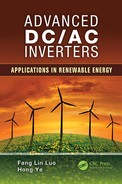Current source inverters (CSIs) have the boost function, but they are not widely applied in industrial applications. Therefore, they are not well discussed in the literature. We have carried out an investigation and obtained the output voltage, which is higher than the input voltage.
4.1 Three-Phase Full-Bridge Current Source Inverter
A typical three-phase full-bridge current source inverter is shown in Figure 4.1 [1,2].
The carrier-based pulse width modulation (PWM) technique is applied in this three-phase full-bridge CSI. The main objective of these static power converters is to produce AC output current waveforms from a DC current power supply. Six switches S1 – S6 are applied and switched by the PWM signal. Figure 4.2 shows the ideal waveforms associated with the full-bridge CSI [1,2].
The CSI has a boost function. Usually, the output voltage can be higher than the input voltage. We can find out the phase ahead between the output voltage and current.
There are two methods introduced in this section: negative polarity input voltage and positive polarity input voltage.
4.2.1 Negative Polarity Input Voltage
Figure 4.3 shows the circuit of the boost-type CSI with negative polarity input voltage [3]. The circuit (vi, L, C, and D plus the load) is a DC/DC boost converter. We point out that the polarity of the input voltage vi is negative. The real voltage vd applied to the following PWM main circuit can be higher than the input voltage vi. Actually, the topology from vd to the output voltage (va, vb, and vc) is a VSI.
FIGURE 4.1
Three-phase CSI.
FIGURE 4.2
Three-phase CSI (ma = 0.8, mf = 9).
FIGURE 4.3
Boost-type CSI with negative input voltage.
For example, we set k = 0.67 and obtain Vd = 400 V, and the output voltage is three-phase 50 Hz/246.6 V (rms, line-to-line). The simulation circuit is shown in Figure 4.4 and waveforms of the input voltage Vin, the middle voltage Vd and output voltages are shown in Figure 4.5.
FIGURE 4.4
Simulation circuit of a boost-type CSI with negative input voltage.
FIGURE 4.5
Waveforms of a boost-type CSI with negative input voltage.
4.2.2 Positive Polarity Input Voltage
Figure 4.6 shows the circuit of the boost-type CSI with positive polarity input voltage. The circuit (vi, L, C, and D plus the load) is a DC/DC boost converter. We pinpoint that the polarity of the input voltage vi is positive. The real voltage vd applied to the following PWM main circuit can be higher than the input voltage vi. Actually, the topology from vd to the output voltage (va, vb, and vc) is a VSI.
FIGURE 4.6
Boost-type CSI with positive input voltage.
FIGURE 4.7
Simulation circuit of a boost-type CSI with positive input voltage.
For example, we sent k = 0.57 and obtain Vd = 475 V, and the output voltage is three-phase 50 Hz/294 V (rms, line-to-line). The simulation circuit is shown in Figure 4.7, and the waveforms of the input voltage Vin, the middle voltage Vd, and output voltages are shown in Figure 4.8.
The third type circuit is CSI with L-C filter as shown in Figure 4.9, which is derived from Figure 4.1 [4,5]. Applying the L-C filter the output voltage can be higher than the input voltage. The simulation circuit is shown in Figure 4.10, and the waveforms of the input voltage Vdc1, the middle voltage Vdc2 and output voltages are shown in Figure 4.11.
FIGURE 4.8
Waveforms of a boost-type CSI with positive input voltage.
FIGURE 4.9
CSI with L-C filter.
FIGURE 4.10
Simulation circuit of a CSI with L-C filter.
FIGURE 4.11
Waveforms of a CSI with L-C filter.
1. Mohan, N., Undeland, T. M., and Robbins, W. P. 2003. Power Electronics: Converters, Applications and Design (3rd edition). New York: John Wiley & Sons.
2. Luo, F. L. and Ye, H. 2010. Power Electronics: Advanced Conversion Technologies. Boca Raton, FL: Taylor & Francis.
3. Yu, R., Wei, X., and Wu, X. 2009. Variable Frequency Current Source Inverter for Grid-Connected PV System. ICEET, pp. 267–370.
4. Mirafzal B., Saghaleini M. and Kaviani A. K. 2011. An SVPWM-based switching pattern for stand-alone and grid-connected three-phase single-stage boost inverters. IEEE Trans. Power Electron., pp. 1101–1111.
5. Saghaleini, M. and Mirafzal, B. 2011. Power control in three-phase grid-connected current-source boost inverter. IEEE Conference, pp. 776–783.











